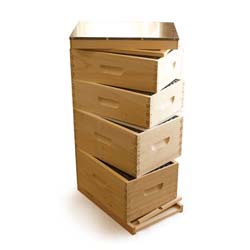Let’s address the question at the heart of winter beekeeping: Do bees actually need our help to survive winter?
The short answer is both simple and complicated—yes, bees can survive on their own, but whether your colonies will thrive without intervention depends on factors that have changed dramatically over the past few decades.
Wild Colonies Survive Every Year
Honey bees survived for millions of years without our help. Right now, in hollow trees and wall cavities across the continent, feral colonies are preparing for winter using the same strategies we’ve discussed—clustering efficiently, raising fat winter bees, and storing honey in carefully organized patterns. Come spring, many will emerge strong and ready to build again.
So yes, bees absolutely can survive winter on their own. The question isn’t whether it’s possible—it’s whether it’s likely for the colonies in our care.
What Makes Natural Survival Work
Wild colonies that succeed at overwintering share several advantages. Natural selection has filtered for genetics that actually survive local conditions—unsuccessful colonies simply don’t pass on their genes. Wild swarms choose nest sites carefully: good drainage, proper volume, appropriate entrance size, and favorable solar exposure. They maintain smaller populations naturally sized for their stored provisions. And they haven’t been bred for traits like gentleness or honey production—characteristics that sometimes come at the cost of hardiness.
Modern Challenges Change the Equation
Today’s managed colonies face obstacles that wild bees don’t encounter—or that affect them very differently.
Varroa mites represent the biggest challenge. These parasites weaken bees, spread viruses, and drain colony resources. While some feral populations develop tolerance through aggressive swarming and smaller colony sizes, they also experience higher mortality—many colonies fail without being noticed.
Breeding priorities emphasize gentleness and productivity over natural hardiness. Hive designs optimize honey production rather than mimicking ideal natural nest sites. Agricultural landscapes limit forage diversity, affecting nutritional quality of stored honey. These factors combine to create an environment quite different from what wild colonies experience.
Understanding “Can” vs. “Will”
Consider survival in extreme conditions: Some people thrive above the Arctic Circle. Others live successfully in scorching deserts. But that doesn’t mean anyone could survive there unprepared.
The same principle applies to bees. They have the biological tools for winter survival, but success depends on genetics, Varroa pressure, stored resource quality and quantity, location, winter severity, and colony strength entering the season.
A weak colony won’t survive regardless of genetics. A strong colony with high mite loads faces terrible odds. A colony with insufficient stores will starve no matter how well they cluster.
Working With Natural Abilities
The goal isn’t to replace bees’ natural abilities—it’s to help them meet modern challenges. When we monitor and manage Varroa, we’re addressing a parasite that wild bees handle through swarming and smaller populations. When we ensure adequate food stores, we’re compensating for agricultural landscapes that limit late-season forage. When we provide proper ventilation, we’re correcting for hive designs that don’t manage moisture like tree cavities do.
The best beekeeping works with natural behaviors, not against them. Understanding cluster dynamics, respecting food storage patterns, and timing interventions to support rather than disrupt colony rhythms—these approaches acknowledge that we’ve placed bees in challenging circumstances and take responsibility for mitigating those challenges.
Setting Realistic Expectations
Here’s an important truth: Winter losses happen. Even the most experienced beekeepers lose colonies. Some winters hit harder than others. Some colonies fail despite excellent preparation. This is part of beekeeping, not a sign of failure.
Some beekeepers follow minimal-intervention approaches that rely on natural selection and accept higher initial losses while building hardy local genetics. Others incorporate standard treatments and management practices common among hobbyist beekeepers. Those practicing natural beekeeping tend to have strong opinions about their approach. But, similarly, most beekeepers have a firm opinion that the use of treatments, in moderation, is justified.
Understanding that bees can survive naturally—but face real modern challenges—helps us make informed decisions about preparation. What specific steps give colonies the best chance? How do we assess true winter readiness? When does intervention make sense?
The answer to “Can bees survive winter on their own?” is: sometimes yes, sometimes no—but with knowledge and preparation, beekeepers can shift the odds in their favor.
